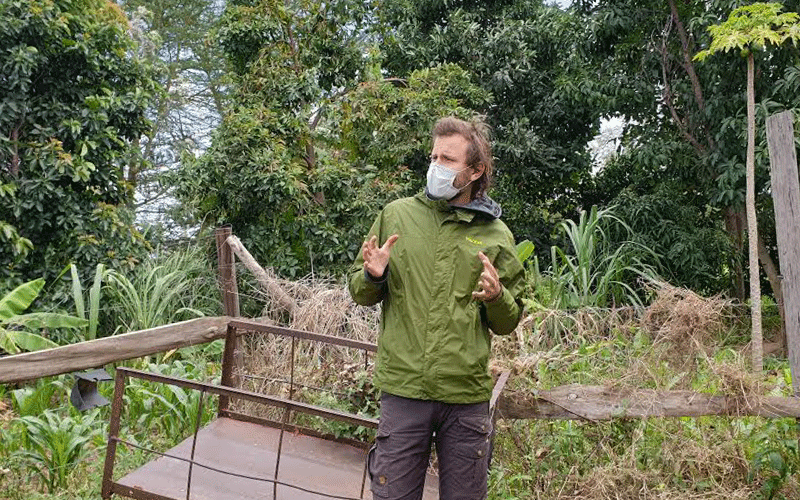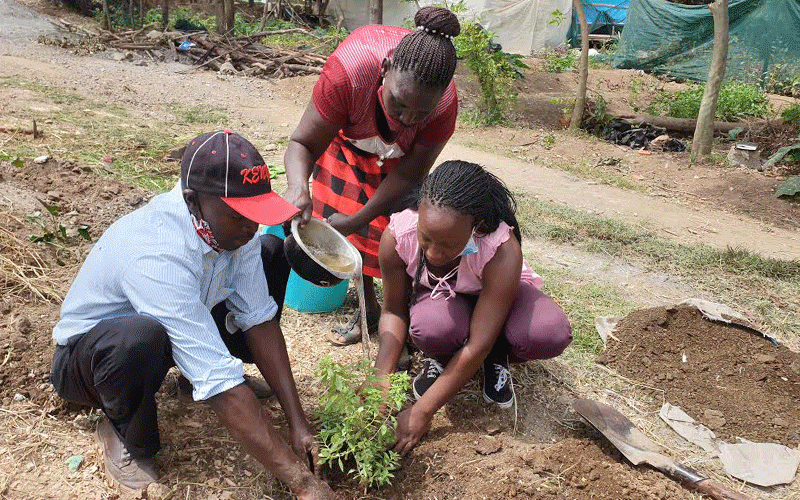Nakuru farmers turn to food forest in fighting hunger

Farmers in Elementaita are turning to a traditional practice known as edible forests to grow and harvest sustainably a variety of crops, balancing a demand for forest products and conservation.
The late Jacinta Waringa during her lifetime did not own a huge track of land where she lived around Lake Elementaita in Gilgil sub-county, Nakuru county.
However, while her neighbours, who also owned small pieces of land complained about lack of food to eat, the story was different at the homestead of the deceased.
She tilled her one-acre piece of land that produced sufficient food and fruits enough for everyone, guided by the words mucii ukuagwo ngaruro, which in a Kikuyu saying meaning ‘a home should at all times have something for a visitor to bite’.
Her grandson, Charles Mwangi has since stuck to the farming practice several years later, with the support of a Non-Governmental Organisation, Seed Savers Network (SSN), which ensures the land has sufficient produce to feed the family and visitors with surplus to sell.
The land has many crops, from maize and beans to sugarcane, traditional vegetables, oranges, paw paws and different varieties of avocado trees.
Interestingly, the trees, even of the same fruit are of different varieties, meaning they flower and fruit at different times.
By having the different food crops, this farm always has something to harvest all year round. 
“This was exactly the concept my late grandmother had when she established this farm back in 2012,” said Mwangi recently when Agribiz visited his farm.
In establishing this food forest, she considered that her grandchildren would have something to eat every time they visited, from oranges, mangoes, sugarcane, avocados, vegetables or any other ready produce.
Mwangi has taken the practice dubbed ‘forest of foods’ a notch higher and is training local farmers the best farming practices and ensures they have relevant local seeds suitable for their ecological areas, and enough for their small parcels of land.
According to Jacob Terwitte, an international permaculture and organic farming trainer, seed diversity allows farmers control over their food systems, protects biodiversity and builds resilience against climate change.
“In African countries where up to 80 per cent of farmers are small-holders, food forests help them to be self-reliant,” he said.
To establish a food forest, Terwitte says one needs to plant different crops, and utilise space both vertically and horizontally.
“Basically, a food forest has several levels. The tallest trees make the canopy, and these can be various varieties of indigenous avocados, jack fruits and custard apples,” he explained adding that the shorter level of trees may be paw paws, and different varieties of oranges, mangoes and pawpaws.
Others borrowing a leaf
The farm has ended up becoming a model, not only around Elementatita and Gilgil areas, but also in Baringo county.
Farmers in Baringo are now practising multiple cropping and seed saving thus reducing food insecurity while increasing diversity of the crops. Saving seed is a direct action to protect crop diversity.
They are being trained on seed selection, seed germination test, saving and record keeping.
This was in preparation to save their harvested seeds in their newly build seed bank, which will be used by farming communities around Lake Bogoria landscape. 
The NGO began its work nearly two decades ago with few small-scale farmers in Gilgil sub-county with the aim of promoting and sensitising farmers on the significance of conserving indigenous and Non-Genetically Modified seeds.
“Over the years, the numbers have grown with farmers saving local seeds in their community seed banks,” said Peris Kamau, a training manager at SSN, noting that farmers should maximise on land use, by embracing food forests.
“We use a multi-pronged and interdisciplinary approaches that enable farmers to attain food security, food sovereignty and seed access.
To achieve our programmes, we integrate various aspects in ecology, seed legal framework, economic and women empowerment,” she added.
Peris said farmers should maximise on land use by embracing food forests and by growing diverse food crops in order to improve access to the same.
“Food forests are also highly organic, meaning farmers will food with minimal residue contamination,” noted Peris.
She encouraged farmers to establish food forests in at least a portion of their pieces of land, as opposed to over reliance on mono-cropping.
“A food forest assures farmers of harvesting from one crop, if a second one fails, especially in this era of climate change and its effects,” she noted.
Besides growing the food crops, farmers can grow timber trees, and practice apiculture within the same farm.
And small animals, such as poultry and rabbits are allowed into the food forests as they don’t disturb the soil much, and their waste enriches the soil.




